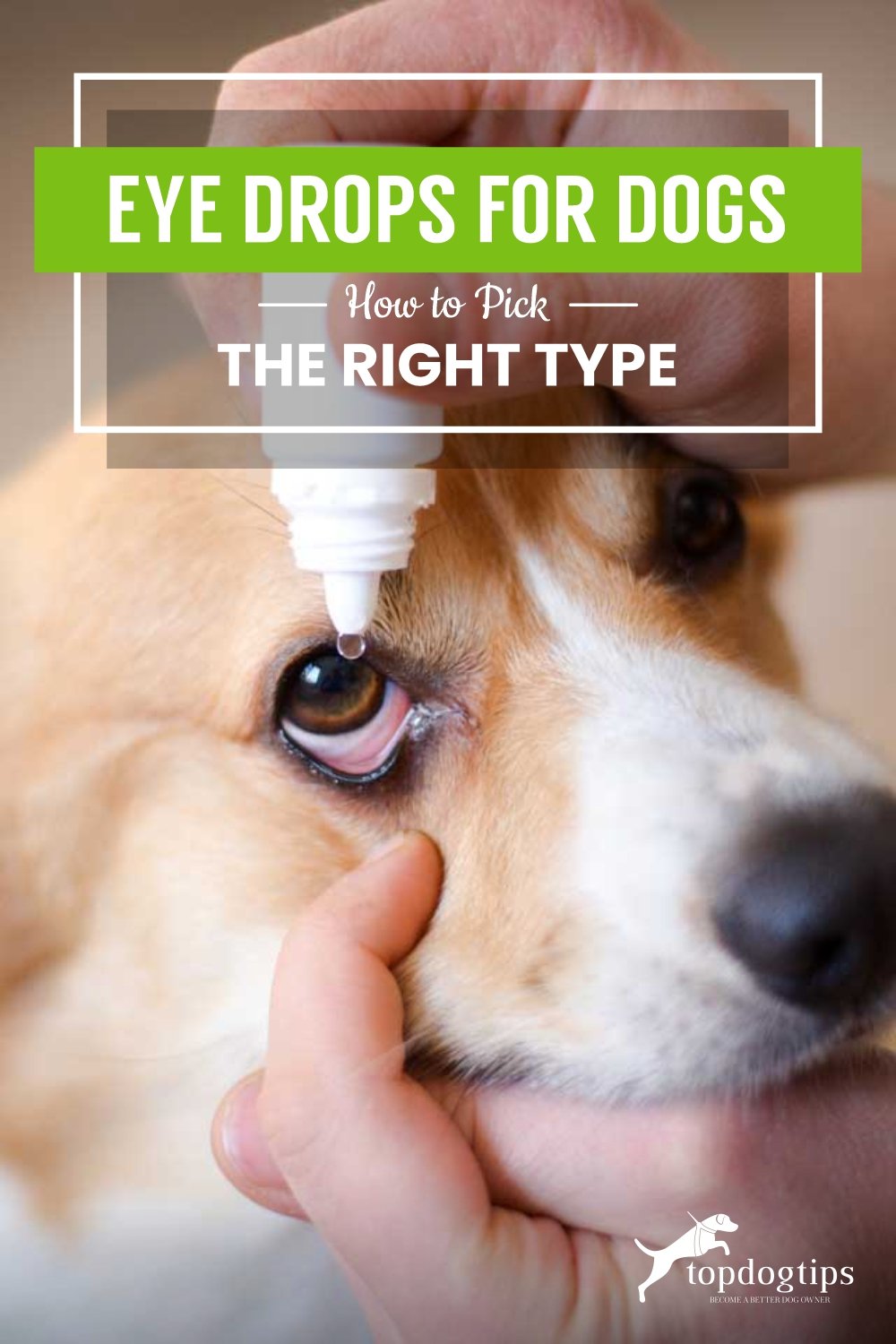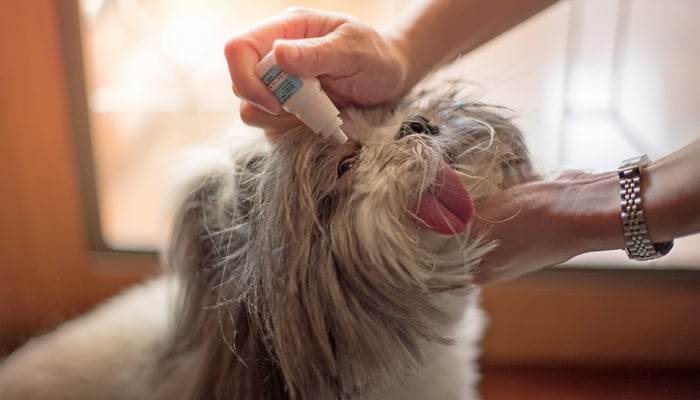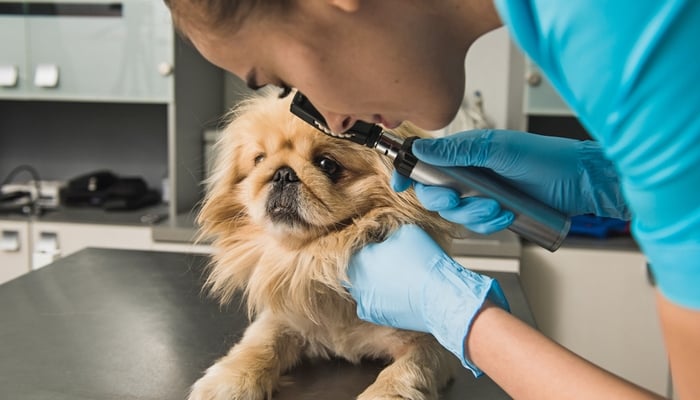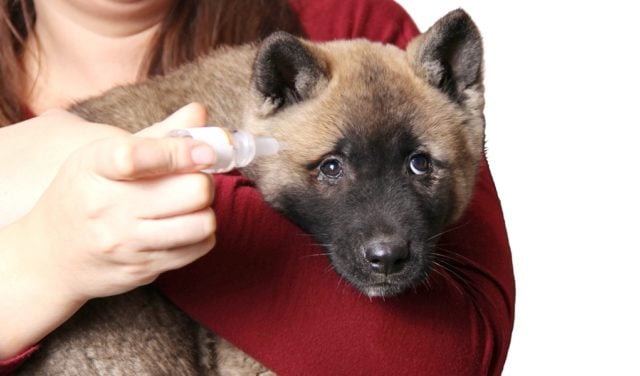
Table of Contents
- Why Use Eye Drops For Dogs?
- Types of Eye Drops for Dogs
- Common Conditions that Require Eye Drops
- 4 Best Eye Drops for Dogs (Antibiotics and Over-The-Counter)
- Treating Your Dog With Antibiotic Eye Drops
- Eye Washes for Dogs
- FAQs About Over-The-Counter Eye Drops for Dogs
- Can I Use Human Eye Drops on My Dog?
- How Can I Treat My Dog's Eye Infection at Home?
- Can I Give My Dog Over-the-Counter Eye Drops?
- How Can I Treat My Dog's Eye Infection?
- What Is the Best Eye Wash for Dogs?
- What Do Vets Prescribe for Eye Infections?
- How Can I Easily Give My Dog His Lubricating Eye Drops?
- How Can I Prevent Eye Issues in My Dog?
- Eye Drops for Dogs: Before You Go…
Ever wonder when you would need eye drops for dogs?
The function and anatomy of your dog’s eye are similar in most ways to your own. However, some differences are present, including a third eyelid, which provides an added layer of protection.
Even with this extra protection, you may still need eye drops for dogs if any issues arise.
Regardless of breed or age, all dogs have this third eyelid, also known as the nictitating membrane. It can vary in color, with some being more noticeable than others.
Many owners notice the nictitating membrane when their dog is asleep, as they have three eyelids.
They can sometimes sleep with two of these open, leaving the third one closed to protect the eye.
However, despite this extra layer of protection, your dogs could still develop eye infections. And trust me, they are the worst!
Aside from causing pain to our pups, it makes them so uncomfortable that sometimes it disrupts their daily activities like playing and even eating!
Fortunately, there are ways you, as dog owners, can alleviate the symptoms.
In this blog, we will our top choices of over-the-counter and antibiotic eye drops for dogs and how you can pick the right one for your pooch!
JUMP TO SECTION
Why Use Eye Drops For Dogs?
Eye drops are basically a topical ointment for eyes, but of course, you can’t go slathering cream on there.
So we use liquid droppers to administer medication or clean the eye.
Keeping the Eye Healthy
Your pooch relies on his vision to live an independent life, and you may be surprised to hear that eye issues in canines are prevalent.
Often this is caused by the long hair surrounding their eyes getting into their eyes and causing irritation. If this is left to progress, it can, in some cases, lead to infection and blindness.
Dogs have a knack for getting into mischief, and your dog may end up with an injury here or there.
It’s important to give him a once-over after a long trip or a walk through overgrown botany.
Checking his eyes for signs of discharge, discoloration, or injury will help you seek immediate veterinary care without allowing a minor issue to progress to a major one.
When it comes to eye issues in dogs, you can never be too careful. It's always best to seek veterinary treatment if you suspect a problem.
| Preview | Product | Rating | |
|---|---|---|---|

|
Burt's Bees for Pets Dogs Natural Eye Wash with... | 3,717 Reviews | Check Price |

|
Ader Pet Vision Pro- for Irritation and Dryness in... | 15 Reviews | Check Price |

|
MicrocynAH Ophthalmic Gel | 904 Reviews | Check Price |

|
Nutri-Vet Eye Rinse for Dogs - Gentle Formula to... | 8,730 Reviews | Check Price |

|
Zoetis Animal Health Terramycin Antibiotic... | 12,197 Reviews | Check Price |
RELATED: 7 Eye Problems In Dogs and How To Deal with Them
Dry Eyes in Dogs
This condition—known formally as Keratoconjunctivitis sicca or KDS—is characterized by, you guessed it, dry eyes.
This often occurs when your dog doesn’t possess adequate tear film over the eye to keep it well moisturized.
It is a pretty common issue that is more irritating than painful for your pooch.
But if untreated, your dog can easily scratch at his eyes to relieve the discomfort and end up causing significant injury.
Some of the more common symptoms include:
- rapid blinking
- protruding third eyelid
- pus on the corner of the eye
- pigment change or reddening
Eye Infections in Dogs
When an eye infection is diagnosed, your veterinarian will likely prescribe antibiotic eye drops to be administered at home.
Many veterinarians prefer to start with an antibacterial eye drop or other more natural methods before moving to antibiotics.
With antibiotic resistance, it’s important only to use them when necessary.
If your dog has been prescribed antibiotics, you should follow your vet's administering guidelines to a T.
Failing to finish a course of antibiotics can leave your dog at risk of re-developing an infection.
In fact, while it seems as though they get a new infection, it’s merely a case of the first infection never fully going away but being dampened down by the antibiotics before striking back when a full course isn’t followed through.
MORE: Eye Infections In Dogs – Diagnosing and Treating Dog Eye Problems
Types of Eye Drops for Dogs
1. Antibacterial Eye Drops
Antibacterial eye drops are the most commonly used eye drops for dogs. They are available to buy over-the-counter at most pet stores or from your local vet clinic.
You can use these on your dog if he has a weeping eye to see if it will clear up without veterinary treatment.
However, always use these over-the-counter eye drops with caution. If used incorrectly, it could worsen your dog's overall condition.
According to Eileen Fatcheric, DVM:
Safe over-the-counter eye drops for dogs are those artificial tears and saline eye drops. Do not use Visine eye drops in dogs. It contains active ingredients that constrict your dog's eye blood vessels. These ingredients are also extremely toxic to dogs which can possibly cause cardiovascular problems.
Of course, we do recommend always seeking expert care for dog eye problems. But if you’re on a budget, you can try these eye drops for a day or two first.
2. Steroid Eye Drops
Prescription steroid eye drops for dogs are used to treat inflammation in the eye.
A very delicate organ, the eye can scar easily due to any inflammation, and steroids are an excellent way to protect against vision loss.
More often, we see a combination of eye drops containing steroids and antibiotics, and these are used to treat inflammation and the root cause of it in one fell swoop.
Common Conditions that Require Eye Drops
1. Allergies
Environmental irritants, including pollen and cleaning products, can irritate your dog’s eyes, nose, and throat.
If it’s impossible to remove your dog’s exposure to these factors completely, you can manage the allergy symptoms with medication and by keeping his living area as clean as possible.
2. Conjunctivitis
Also known as pink eye, conjunctivitis in dogs occurs when the conjunctiva—the moist area of the under-lid—becomes inflamed.
There are multiple reasons that this can happen, most notably from an allergic reaction or dry eyes.
Symptoms of this condition include:
- squinting
- rapid blinking
- swelling of the area
- pus seeping from the eye
Treatment for conjunctivitis is ordinarily done by cleaning the affected area and treating it with a combination of steroid/antibiotic eyedrops.
3. Epiphora
Not a medical condition per se, epiphora is the name for an overflow of tears from the eye.
A normal, healthy eye will produce tears to keep the eye well-lubricated. The excess is drained down into the tear ducts.
But in this instance, the tears leave the eye and leave your dog with a constant or frequent weeping appearance.
The most obvious sign of this ailment is the obvious wet streaks on your dog’s face, and in time, the red or brown staining in these areas.
A more serious condition may be present, such as development issues with the tear ducts.
Therefore, your veterinarian should be seen, but you can do home management by keeping the area clean and using specific eye drops.
4. Breed-Specific Issues
Certain breeds are more prone to eye conditions.
According to a study, flat-faced or brachycephalic dog breeds tend to get eye infections, especially Pugs.
This also includes other short-nosed breeds, like Pekingese, Boxers, Bulldogs, and the like.
But, it’s not just these smooshy-face fluffballs that have issues.
Dogs with loose facial skin suffer from a fair amount of eye problems, including:
Poor flopsy-faced pooches.
SIMILAR: Cherry Eye in Dogs – What It Means and How To Deal with It

4 Best Eye Drops for Dogs
(Antibiotics and Over-The-Counter)
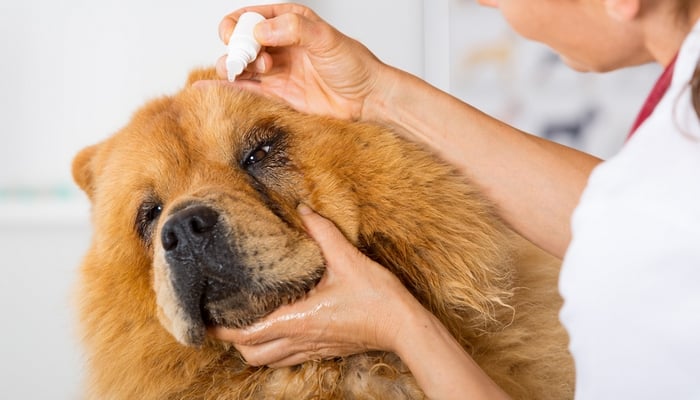
Many different eye drops are available for canine use. Many serve the same purpose, but others are only meant for specific conditions and afflictions.
For minor eye irritation, buying over-the-counter medicine is quite acceptable.
Still, if your dog suffers from more serious symptoms, you should always consult with a veterinarian before using any medication.
1. Neo Poly Dex Ophthalmic
Used to treat infections and inflammation, this specific eye drop contains two types of antibiotics and asteroids.
Ordinarily applied every two to four hours when using the drops. Still, ointment is also available, which can be applied every eight to twelve hours—both of these, of course, depend on your dog’s specific diagnosis.
2. Terramycin Ophthalmic Ointment
An antibiotic treatment that is commonly used to treat conditions such as conjunctivitis and inflammation of the eyelid.
The drops work thanks to the active ingredient oxytetracycline blocking any bacteria's ability to grow and multiply whilst killing off those present.
Terramycin Ophthalmic Ointment can be used for dogs, horses, and cats, with an average treatment period of around four days.
If you don’t see results at the end of this period, you should discuss other medications with your vet.
3. Gentamicin Sulfate Ophthalmic Solution
In antibiotic treatment for canines suffering from bacterial infections, the active ingredient aminoglycoside binds with any present bacteria and inhibits protein synthesis, which in layman's terms—kills the bacteria!
This treatment cannot be used for animals suffering from a viral or fungal infection and should also be avoided for bitches in pups or those that are lactating.
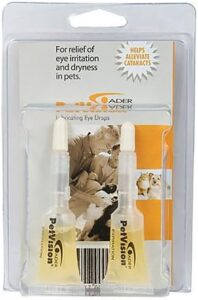
4.Pet Vision Lubricating & Cataract Eye Drops - 8 ml
This eye drop is designed for longer-term use for ongoing eye conditions such as:
- incipient and immature cataracts
- nuclear sclerosis
- dry eye syndrome
Ader Enterprises Pet Vision Pet Vision Pro should be applied twice daily for a minimum of thirty days to see a noticeable improvement.

5. MicrocynAH Ophthalmic Gel
MicrocynAH Ophthalmic Gel is a gel used to help prevent or relieve dryness in your dog’s eyes. It provides a base layer over the eye, thus providing added protection while lubricating to remove dryness and irritation.
This ointment is used by applying it on the lower lid and should be administered when necessary.
Depending on the condition or ailment that your dog is suffering from, your veterinarian may be able to give you an idea of how often you may need to reapply.
WATCH: How To Give A Dog Eye Drops – A Step-by-Step Instructional Video
Treating Your Dog With Antibiotic Eye Drops
If this is your first time giving antibiotic eye drops for dogs, you might be a little hesitant to do it yourself.
With an uncomfortable pooch and its sensitive eyes, it could be extra challenging for you.
Fortunately, it doesn't have to be that hard to administer antibiotics or over-the-counter eye drops for dogs.
Check out this video and learn how you can easily give dog eye drops to your pup:
Eye Washes for Dogs
Before administering eyedrops, you must start by cleaning out the affected area, and that goes for every time you re-administer.
Sometimes using plain water may not be enough to sterilize the area, so check out these eye washes for dogs you can use:
 1. Tomlyn Opticlear Dog & Cat Sterile Eye Wash to...
1. Tomlyn Opticlear Dog & Cat Sterile Eye Wash to...
Manufactured in a human-grade facility, this eyewash helps to relieve discomfort and itching caused by environmental pollutants by helping to sterilize your dog of any pollutants he may have picked up, such as pollen.
Tomlyn Sterile Eye Wash for Dogs and Cats is specifically designed to be gentle on your dog’s eyes by being produced at the same pH level as your pup's own tears.
 2. Burt's Bees for Pets Dogs Natural Eye Wash with...
2. Burt's Bees for Pets Dogs Natural Eye Wash with...
A gentle saline solution designed to safely clean your dog’s eyes by mimicking your dog’s own tears.
Using all-natural ingredients, Burt’s Bees Eye Wash Solution for Dogs avoids any chemical irritants that could end up causing more irritation to your dog.
Use as directed on the packaging by squeezing two to three drops directly into your dog’s eye to clean away any debris or clean out minor scrapes.
FAQs About Over-The-Counter Eye Drops for Dogs
If you want some of the above information in a more concise format, this FAQ should help.
It will also answer any lingering questions that dog owners may have about dog eye care.
Can I Use Human Eye Drops on My Dog?
I know it might seem like the dog's eyes are probably the same as ours, so you assume, “Well, why don't I use my eye drops for my dog?”
DO NOT use your eye drops on your dog's eyes without consulting your vet first. Medication for dogs is almost always different, even if you are treating something as basic as conjunctivitis.
Are There Any Exceptions?
There is only one exception to this rule. Only put human drops in your dog's eyes if your vet tells you to do so.
They are familiar with dogs' eyes and know what is safe to use. Otherwise, you put your pooch at risk of irritating eyes or worse.
How Can I Treat My Dog's Eye Infection at Home?
If your dog is on other medication that you worry may not mix well with eyedrops, it is possible to make an all-natural eyedrop using just salt and water.
Mix ¼ of a teaspoon of salt with one cup of lukewarm water in a sterile container and use three to four times per day when necessary.
If you want more treatment ideas at home instead of using antibiotic eye drops for dogs, you might want to check this video:
Can I Give My Dog Over-the-Counter Eye Drops?
The answer to this question depends on which drops they are. If the over-the-counter eye drops are marketed to humans, then the answer is NO.
As we already said, human medications, including eye drops, are not for dogs.
If the drops are designed for dogs, then this is another story. It is still best, however, to consult your vet first.
Ocular health is complicated. To avoid issues, you should always consult your vet before putting anything in your pup's eyes.
How Can I Treat My Dog's Eye Infection?
If your dog has a bacterial infection or another type of infection in his eye, you want to consult his vet.
The vet will look at your pet's eyes to determine the problem. Then, he will use that information to determine the ideal treatment for your furry friend.
He will start by taking care of any underlying cause. An example would be removing a foreign body in the eye.
Options can include eye gel, medications designed specifically to treat your pup's condition, drops, or ointments. The vet may even suggest wearing dog goggles.
If there are secondary infections, your vet will also treat those. Depending on the situation, he may also prescribe your pooch pain medicine.
What Is the Best Eye Wash for Dogs?
Your vet's office can suggest an eyewash for your pup. The best choice will depend on the eye problems in question.
That being said, any of the eye washes listed above are great choices.
What Do Vets Prescribe for Eye Infections?
One of the most common treatments for doggy eye infections is ciprofloxacin.
This brand of eye drops treats bacterial infections, including conjunctivitis.
How Can I Easily Give My Dog His Lubricating Eye Drops?
Whether you need to give your pup lubricating eye drops or another type of eye drop or wash, it can be a bit challenging to do so.
Your dog may not be the most cooperative.
Before giving your dog the drops, clean the eyes with a cotton ball and some warm water. Then, tilt his head back slightly.
Put your hand on his head to reduce the risk of movement. Dog owners can also try balancing their hands on their dog's head, so the dropper does not get too close to the eye.
This prevents accidentally hitting the eye with the dropper.
For ointments, you want to follow a similar process.
The difference is that you will need to gently pull your pup's lower lid down so the ointment can go into the pocket you create.
How Can I Prevent Eye Issues in My Dog?
From eye irritation to pink eye to dry eye, you want to prevent eye problems in your dog. The best advice for doing so is to look at your pup's eyes regularly.
Please make sure the pupils are the same size and there is white around his irises. You don't want to see crust, tearing, or squinting.
If you gently pull your dog's lower lids down, they should look pink. If they look white or red, take him to the vet.
It would help if you also were on the lookout for any indications of a possible problem.
If you notice yellow, green pus, dry eye, watery eyes, cherry eye, protruding eyes, or corneal ulcers, consult your vet.
He will thoroughly examine your pup's eyes to confirm his ocular health is good.
You can also help reduce the risk of issues by keeping irritants away from his eyes and trimming back long fur by his eyes.
Eye Drops for Dogs: Before You Go…
Your dog can’t speak up when he’s in pain or uncomfortable, so you must keep an eye on his overall health.
It can be as simple as doing a quick home checkup every month or so to see if his eyes look cloudy or weepy at all.
Trust me, this two-minute act could ultimately save his vision.
That might sound dramatic, but I am deadly serious. Pets have gone blind from a minor issue being left to fester and get to the stage where they are beyond repair before an owner realizes something is wrong.
Be the proactive owner that your pets deserve. And hey, don’t worry, administering eye drops for dogs doesn’t have to be a major cause for concern.
It’s a super-easy task that almost always fits in with your current schedule!
RELATED READS:
- How To Apply Eye Ointment To A Dog
- My 3 Favorite Dog Eye Infection Home Remedies
- Top 5 Best Dog Eye Care Products
Disclosure: We may earn affiliate commissions at no cost to you from the links on this page. This did not affect our assessment of products. Read more here and find full disclosure here.
